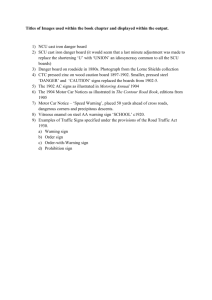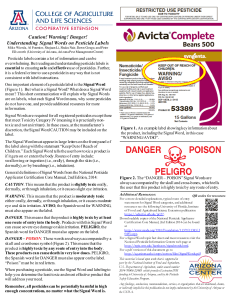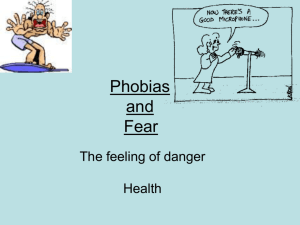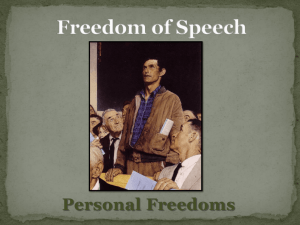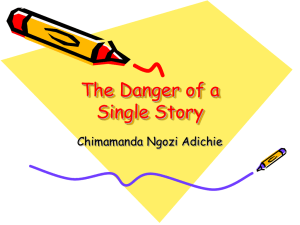2/25/2016 Michael R. Wierda, Ph.D. Michael R. Wierda, Ph.D. University of Arizona, Arizona Pest
advertisement
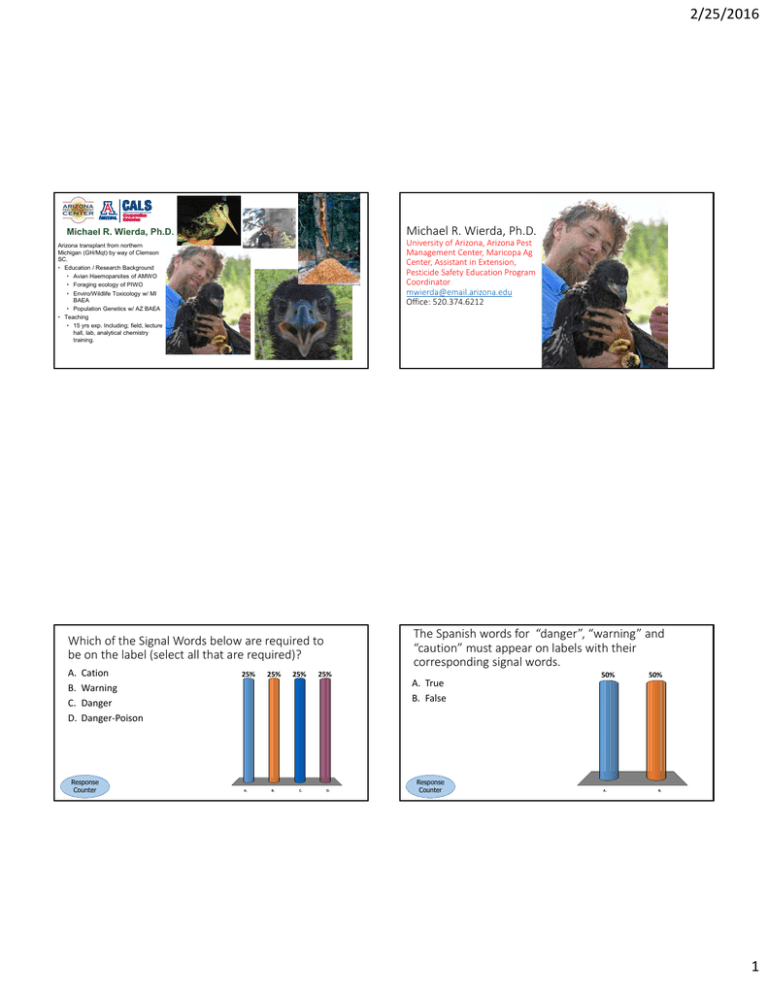
2/25/2016 Michael R. Wierda, Ph.D. Michael R. Wierda, Ph.D. University of Arizona, Arizona Pest Management Center, Maricopa Ag Center, Assistant in Extension, Pesticide Safety Education Program Coordinator mwierda@email.arizona.edu Office: 520.374.6212 Arizona transplant from northern Michigan (GH/Mqt) by way of Clemson SC. • Education / Research Background • Avian Haemoparsites of AMWO • Foraging ecology of PIWO • Enviro/Wildlife Toxicology w/ MI BAEA • Population Genetics w/ AZ BAEA • Teaching • 15 yrs exp. Including; field, lecture hall, lab, analytical chemistry training. Which of the Signal Words below are required to be on the label (select all that are required)? A. B. C. D. Cation Warning Danger Danger‐Poison Response Counter 25% A. 25% B. 25% C. 25% D. The Spanish words for “danger”, “warning” and “caution” must appear on labels with their corresponding signal words. A. True B. False Response Counter 50% A. 50% B. 1 2/25/2016 Which Signal Word means that the product is highly toxic by at least one route of entry into the body. Products with this Signal Word can cause severe eye damage or skin irritation. 25% A. B. C. D. 25% 25% 25% Caution Warning Danger Danger‐Poison How are Signal Words chosen? • Before the EPA can determine the appropriate signal word for a pesticide product, the manufacturer performs research on laboratory animals to determine the toxicity of the formulation. • Required studies include oral exposure (eating the product), inhalation exposure (breathing in the product), dermal exposure (spreading the product on the skin) and exposures to the skin and eyes to check for irritation. • The study that shows the highest toxicity is used to determine the signal word.1 • For example, if a product demonstrated low toxicity when eaten, moderate toxicity when inhaled, and high toxicity when applied to skin, the EPA would assign the signal word DANGER, based on the most sensitive route of entry. In this example it was the skin.2 1 Label Review Manual; U.S. Environmental Protection Agency, Office of Prevention, Pesticides, and Toxic Substances, Office of Pesticide Programs, U. S. Government Printing Office: Washington, DC, 2 2007.http://www.epa.gov/oppfead1/labeling/lrm/chap‐07.pdf (accessed June 2008), updated Aug 2007. Whitford, F. The Complete Book of Pesticide Management: Science, Regulation, Stewardship, and Communication; Wiley & Sons: New York, 2002; pp 450‐452. Response Counter A. B. C. D. Signal Words and Symbols Signal words indicate the relative acute toxicity to humans and animals Very low toxicity signal words not required Large letters on the front panel of the label w/ “Keep Out of Reach of Children.” Danger-Poison Warning Danger Caution Signal Words DANGER - POISON Highly toxic by any route of entry DANGER-POISON PELIGRO PRECAUTIONARY STATEMENTS HAZARDS TO HUMANS AND DOMESTIC ANIMALS 2 2/25/2016 Signal Words DANGER = highly toxic by at least one route of entry into the body. Products with this Signal Word can cause severe eye damage or skin irritation DANGER PELIGRO PRECAUTIONARY STATEMENTS HAZARDS TO HUMANS AND DOMESTIC ANIMALS DANGER Causes irreversible eye damage..... More Signal Words WARNING AVISO = moderately toxic either orally, dermally, or by breathing, or may cause moderate eye and/or skin irritation CAUTION = slightly toxic either orally, dermally, or by breathing, or may cause slight eye and skin irritation 3 2/25/2016 Choose the least toxic chemical that gives the desired level of control! Summary of Signal Words CAUTION. This means that the product is slightly toxic orally, dermally, or through inhalation, or it causes slight eye irritation. WARNING. This means that the product is moderately toxic either orally, dermally, or through inhalation, or it causes moderate eye and skin irritation. AVISO, the Spanish word for WARNING, must also appear on the label. DANGER. This means that the product is highly toxic by at least one route of entry into the body. Products with this Signal Word can cause severe eye damage or skin irritation. PELIGRO, the Spanish word for DANGER must also appear on the label. DANGER – POISON. These words are always accompanied by a skull and crossbones symbol. This means that the product is highly toxic by any route of entry into the body. These products can cause death in very low doses. PELIGRO, the Spanish word for DANGER must also appear on the label. “Poison” must be in red letters. 4 2/25/2016 Which of the Signal Words below are required to be on the label (select all that are required)? A. Cation B. Warning C. Danger D. Danger-Poison Response Counter 25% A. 25% B. 25% C. 25% D. Which Signal Word means that the product is highly toxic by at least one route of entry into the body. Products with this Signal Word can cause severe eye damage or skin 25% 25% 25% 25% irritation. A. Caution B. Warning C. Danger D. Danger-Poison The Spanish words for danger , “warning” and “caution” must appear on labels with their corresponding signal words. 50% 50% A. True B. False Response Counter Caution! Warning! Danger! Understanding Signal Words on Pesticide Labels The Signal Word must appear in large letters on the front panel of the label along with the statement “Keep Out of Reach of Children.” Each Signal Word tells the user how toxic a product is if it gets on or enters the body. Routes of entry include: swallowing or ingestion (i.e., orally), through the skin (i.e., dermally), or by breathing (i.e., inhalation). General definitions of Signal Words from the National Pesticide Applicator Certification Core Manual, 2nd Edition, 2014: CAUTION. This means that the product is slightly toxic orally, dermally, or through inhalation, or it causes slight eye irritation. WARNING. This means that the product is moderately toxic either orally, dermally, or through inhalation, or it causes moderate eye and skin irritation. AVISO, the Spanish word for WARNING, must also appear on the label. DANGER – POISON. These words are always accompanied by a skull and crossbones symbol (Figure 2). This means that the product is highly toxic by any route of entry into the body. These products can cause death in very low doses. PELIGRO, the Spanish word for DANGER must also appear on the label. “Poison” must be in red letters. A. B. C. D. – UA Arizona Pest Management Center – Available at the The University of Arizona Field Crops IPM Shorts page. One important element of a pesticide label is the Signal Word (Figure 1). But what is a Signal Word? What does a Signal Word mean? This short communication will explain why Signal Words are on labels, what each Signal Word means, why some pesticides do not have one, and provide additional resources for more information. Signal Words are required for all registered pesticides except those that meet Toxicity Category IV (meaning it is practically non-toxic and not an irritant). In these cases, at the manufacturer’s discretion, the Signal Word CAUTION may be included on the label. B. • Saftey Words Short from Mike Wierda, Al Fournier, Shujuan Li, Shaku Nair, Dawn Gouge, and Peter Ellsworth (University of Arizona, Arizona Pest Management Center) Pesticide labels contain a lot of information and can be overwhelming. But reading and understanding pesticide labels is essential to ensuring safe and effective use of pesticides. Further, it is a federal crime to use a pesticide in any way that is not consistent with label instructions. DANGER. This means that the product is highly toxic by at least one route of entry into the body. Products with this Signal Word can cause severe eye damage or skin irritation. PELIGRO, the Spanish word for DANGER must also appear on the label. Response Counter A. Figure 1. An example label showing key information about the product, including the Signal Word, in this case “WARNING/AVISO”. • http://cals.arizona.edu/crop/cotton/a gronomic_ipm.html Figure 2. The “DANGER – POISON” Signal Words are always accompanied by the skull and cross-bones, which tells the user that this product is highly toxic by any route of entry. Additional Resources: QR codes for For a more detailed explanations, typical route of entry statements resources for Signal Word categories, and additional resources see the following University of Florida, Institute of Food and Agricultural Science Extension publication https://edis.ifas.ufl.edu/pi137 Downloadable copies of the National Pesticide Applicator Certification Core Manual, 2nd Edition 2014 can be found at http://www.nasda.org/9381/Foundation/11379/11383/304 85.aspx For a Signal Word topic fact sheet and more resources visit the National Pesticide Information Centers web page at http://npic.orst.edu/factsheets/signalwords.html For a downloadable pdf of this document go to http://ag.arizona.edu/crops/cotton/files/SignalWords.pdf When purchasing a pesticide, use the Signal Word and labeling to help you determine the least toxic and most effective product that will address your need. This material is based upon work that is supported in part by the National Institute of Food and Agriculture, U.S. Department of Agriculture, under award number 2014-70006-22488 which provides Extension IPM funding to University of Arizona, and by the Pesticide Safety Education Program. Remember, all pesticides can be potentially harmful in high enough concentrations, no matter what the Signal Word is. Any findings, conclusions, recommendations, services, or organizations that are mentioned, shown, or indirectly implied in this publication do not imply endorsement by the University of Arizona or the USDA. – Or this direct URL • http://ag.arizona.edu/crops/cotton/fil es/SignalWords.pdf 5 2/25/2016 Which of the Signal Words below are required to be on the label (select all that are required)? The Spanish words for “danger”, “warning” and “caution” must appear on labels with their corresponding signal words. 100 Cation 100 100 True 100 100 Warning 100 100 Danger 100 100 False 100 100 Danger‐Poison 100 First Slide Second Slide First Slide Second Slide Which Signal Word means that the product is highly toxic by at least one route of entry into the body. Products with this Signal Word can cause severe eye damage or skin irritation. 100 Caution 100 100 Warning 100 100 Danger 100 100 Danger‐Poison 100 First Slide Second Slide 6
